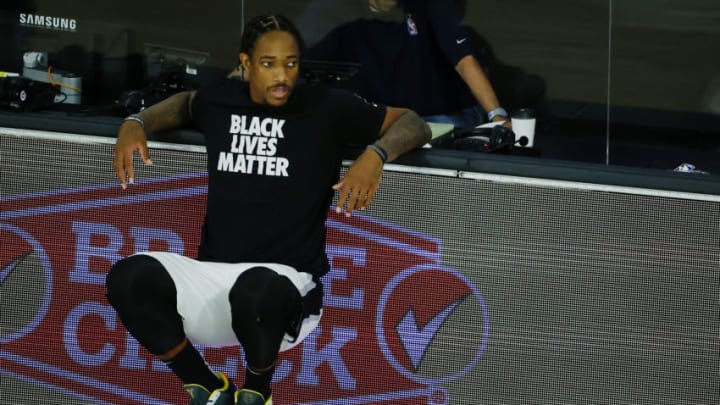DeMar DeRozan, the footwork game and complicated relationships
By Kevin Yeung

How do you reconcile DeMar DeRozan’s exquisite footwork and mid-range excellence with the understanding that they are also the ceiling of his game?
I want to like DeMar DeRozan. I definitely like the idea of DeMar DeRozan, which is of great, engineered footwork that can pivot and counter and transition from place to place as the situation calls to create a bucket. Footwork is a fundamental part of the game, and if you’ll tolerate me sounding like a narc for a second here, it’s also one of the sexiest parts of the game. Footwork is the building block that leads to crossover chains, spins and fakes, steps through or around or under, all things that are fading from the economy of today’s ball movement and catch-and-shoot game. Great footwork is carried forward in the games of step-back shooters like James Harden or Jayson Tatum and off-screen shooters like Duncan Robinson and J.J. Redick, but DeRozan’s game is contrarian, a time machine that exists in defiance of everything everyone else does right now.
In the past, particularly his Toronto Raptors days, it would be easy to wax poetic for DeRozan, a Compton-born Kobe acolyte who seems like a great dude in general — only to watch his great footwork manifest in bad shots from deep mid-range. That’s not on him, necessarily; one-on-one basketball is a rigged game against all but the very best of players. This season, actually, is the most efficient of DeRozan’s career by far. Gregg Popovich and the San Antonio Spurs have completely excised the 3-pointer from his game and done what they could about the long 2s. He’s encouraged to work with the ball from the mid-post, to work, work, work towards floater range and the rim. This year for him has been a parade to the free-throw line, and a master class of scoring in and around the paint. Without immediate blow-by speed or the threat of a 3-point shot, DeRozan has to leverage a sheer knowledge of moves to create opportunity. He’s reactive, operating in lockstep with his defender. What they try to take away determines what he does.
Ironically, DeRozan has one of the most similar games in the league to the player that he replaced in San Antonio. Both DeRozan and Kawhi Leonard have great footwork, expansive mid-range games and are learned passers. The problem is, Kawhi can shoot 3s and lock down on defense, and he’s better from the mid-range to boot. He doesn’t have as many moves as DeRozan, but he doesn’t really need them. His combination of upper-body strength and body control means that it’s difficult for defenders, even multiple defenders, to faze him from the natural motion of his shot. He’s a battering ram, while DeRozan is a shapeshifter. What I’m saying is, DeRozan primarily identifies by something that Kawhi does better and isn’t restricted to. Even with this being the most efficient season of DeRozan’s career, the Spurs are at risk of missing the playoffs for the first time in 23 years.
DeMar DeRozan both leads and limits the San Antonio Spurs
This is where reality breaks the myth. DeMar DeRozan is good, but not quite good enough. He has a lot in common with his teammate LaMarcus Aldridge, who also falls into the categories of being good, not great, and aesthetically a relic. Both see themselves as go-to guys, with often dismal defensive effort to match. As a core, they feel like transitory pieces to the next era of Spurs basketball, which right now looks like Dejounte Murray and Derrick White, instead of any substantive means to an end of their own. In fact, Aldridge’s injury has catalyzed the best stretch of Spurs basketball all season long in the Orlando bubble. The Spurs added Lonnie Walker to the starting lineup and shifted DeRozan over to Aldridge’s position of power forward; the result, with four dynamic ball-handlers in the offense, has been an equal-opportunity drive-and-kick system. This role doesn’t marginalize DeRozan per se, but he becomes just another cog instead of the feature piece. This is the most that the Spurs have looked like a playoff team all season.
Against the New Orleans Pelicans on Sunday, with the Spurs needing a win to keep their playoff hopes alive, DeRozan dropped 27 points with 15 in the fourth quarter to get the win. It was just the second time through six bubble games that DeRozan led the Spurs in shots, but he leads the entire bubble in fourth-quarter scoring. The egalitarian approach seems to be a winner on the whole, but so does letting him take over in the fourth when he’s feeling himself and has the moves for every attempt to check him. It’s hard for players like DeRozan to be good this way, but it looks so, so good.
Leading the league in 4th quarter points since the NBA Restart, @DeMar_DeRozan puts up 15 in the 4th (27 total) to move the @spurs closer to 9th in the West! #GoSpursGo #WholeNewGame pic.twitter.com/SGLLCemarY
— NBA (@NBA) August 9, 2020
See, in the abstract, I know who DeMar DeRozan is and the degree to which he’s good, but probably not great as a basketball player. Then, every once in a while, he’ll have the games where I’m like, damn, I do see the greatness after all. I have been circling back to the idea of DeMar DeRozan for more years than I can count, and I don’t know just how much things have really changed. I think DeMar DeRozan is toxic for me.
SUBSCRIBE. Get The Whiteboard delivered daily to your email inbox. light